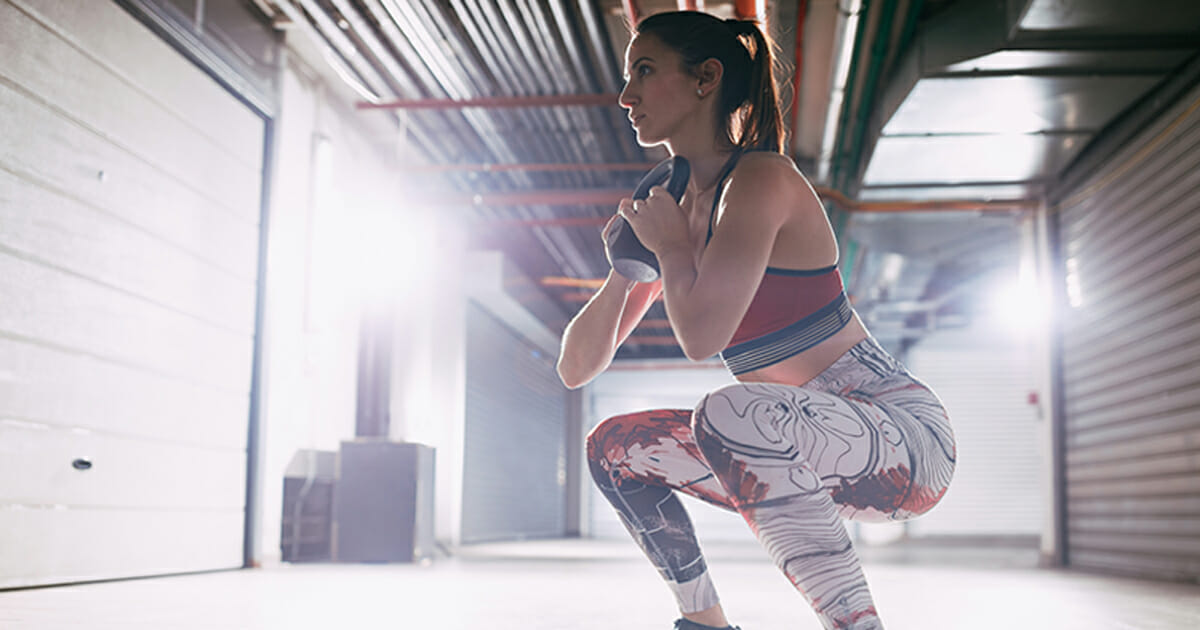The Goblet Squat – Really Beneficial?
You’ve read it over and over again: do your squats! But still, why is everybody so fascinated with squatting? Well, squatting has some great health benefits, such as promoting healthy bone growth. It’s a perfect exercise for your glutes and quads, and it stimulates your heart when it’s done properly.
Now, there’s a way to move your squats to the next level — goblet squats. They are similar to normal squats, except with a kettlebell or a compact weight in your hands below your throat. Even if you haven’t mastered traditional squats yet, goblet squats can be a major help. They help to distribute energy throughout the exercise, pushing you to stay in good shape during the exercise. It’s because holding something (a medicine ball, a bottle of water, heck — even your cat!) makes you keep your torso upright. So, you’re in a position to have a super successful, core-blast workout.
Let’s learn a bit more about the goblet squat, the
benefits of this power move, and some ways to incorporate it into your workout
routine.
What is a Goblet Squat?
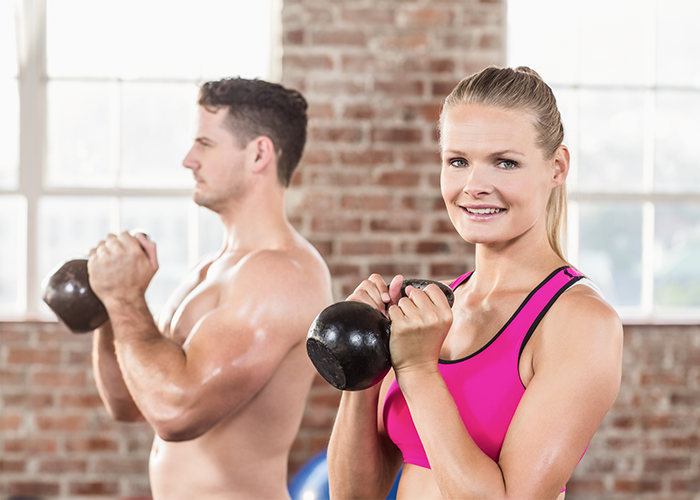
A goblet is a kind of ornate drinking cup that is usually used in ceremonies.
Goblets can be larger than your average glass of wine, and you can normally drink it with two hands. When you do that, it’s a representation of the posture you should have with your arms during the goblet squat. Basically, you’re holding something close to your chest and you’re keeping your elbows down. Then, well, you were squatting!
It’s an amazing way to understand proper form for standard squats too. Just holding something during this exercise, even if it’s not a weight, can help align your back and improve posture.
4 Goblet Squat Benefits That Make it Worth the Burn
Typical squats are known for their booty-building benefits. The problem is that so many people aren’t doing them the right way. Goblet squats give you proper form, plus a number of other health benefits. It’s great for strength, conditioning, and rehabilitating small injuries.[2]
1. Encourages better form
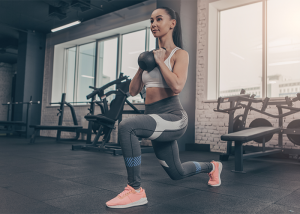
What makes this move so versatile is that both beginners and heavy lifters can benefit from it. In short, the goblet squat forces you to squat more upright, rather than leaning forward. When you lean forward, you can injure yourself and put stress on your knees.
If you’re new to squatting, this is a great way to begin the right way. If you’re more experienced and interested in building muscle, simply add more weight to the move.
2. Lifts your booty
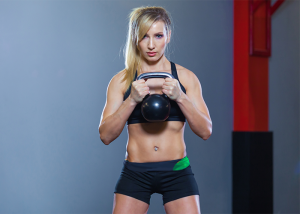
Have you ever squatted too low and felt tension in your knees? That’s because you weren’t distributing your weight properly.
Goblet squats can fix that. Because you have better form, you can drop down lower to the ground. This enables you to work those glute muscles harder when you lift back up. In no time, you’ll feel your tush become more rounded and ready for a bikini vacation in Hawaii!
3. Better mobility
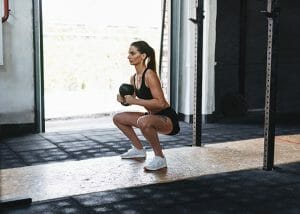
You squat throughout your daily life without even knowing it. For example, you sit on chairs and pick things up off the ground. These are all forms of squatting. However, these everyday movements can irritate your knees and lower back if you’re stiff or aren’t making these moves with full mobility in your joints.[3]
Goblet squats can help you build a better range of motion in your hips, taking pressure off the knees and spine.[4] If you try these squats with a resistance band around your legs, it will help you build strong joints too.
4. Fewer injuries
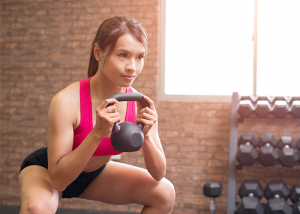
Increased flexibility helps prevent injuries. If you’re already leading an active lifestyle, goblet squats are a great tool to work on your flexibility and increase your hip mobility. For powerlifters and runners specifically, lots of hip mobility is key to prevent injuries.[5]’[6]
Additionally, they also target the posterior muscles, which are along the backside of the body.[7] That’s also important for reducing injuries when bending over to pick things up or lifting heavy objects.
Tip: Try looking in the mirror to check your form when you first learn how to do this squat. That way, you can see your posture in real time and correct any shortcomings.
Master Correct Goblet Squat Form: Instructions &
an Integrated Workout
Now it’s time to get to the nitty-gritty. You can start doing these squats at home with your own makeshift equipment or in the gym. The important thing is to remember how to avoid any injuries. If you focus the weight in your knees, you could risk hurting yourself. The best thing to do is really focus on your hips during the movement and place your weight back rather than forward.[8] You should do your best to drop as low as possible in these exercises, while still maintaining balance.
Tip: Start off with lighter weights and gradually increase them as you build strength.
DB / Dumbbell Goblet Squat | 10 reps
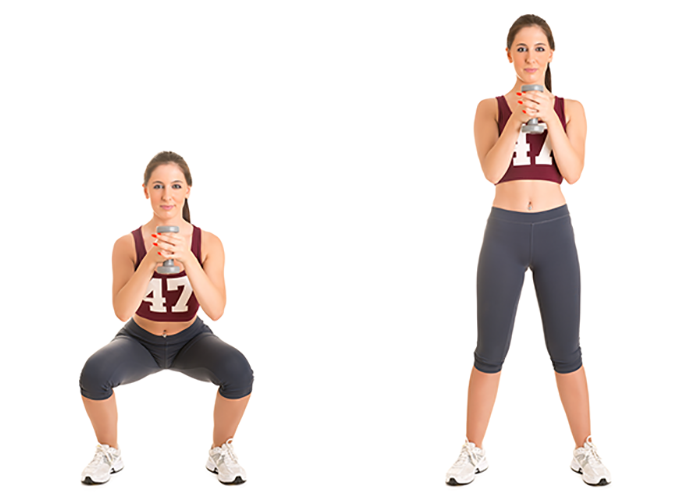
The dumbbell squat is also known as the DB squat for short or the “sumo squat”.[9] Don’t be scared to really get into this movement! You might feel a bit off balance and wobbly at first, but keep practicing and you’ll start to feel yourself getting stronger.
Equipment you’ll need
- One dumbbell
How to do it
- Hold the dumbbell lengthwise so that you’re grasping the sides of the top weight plate. Hold it close to your chest. Your elbows should be bent and pointed down. Keep your arms in this position throughout this move.
- Use your core muscles to keep your back upright and straight. Then, lower into a squat by bending your knees. The dumbbell should stay at your chest level, and only your bottom half should be in motion.
- Pause at the bottom of your squat, then slowly come back up.
- Get back to your starting position and repeat for 10 reps.
Kettlebell Goblet Squat | 10 reps
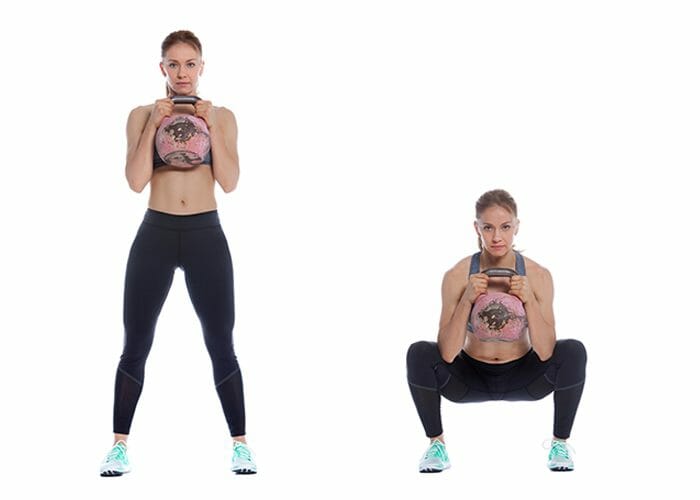
The kettlebell goblet squat is one of the more popular ways to goblet squat. It allows you to have a better grip on the weight, and add in a lift between squats if you want.
Equipment
you’ll need
- One kettlebell
How
to do it
- Hold the kettlebell with both hands at chest level. Your arms should be bent, with your elbows facing downwards.
- Lower down into a squat, whilst keeping your back upright and straight. Make sure to look forward and not down. This will help you keep balance.
- Sink deep into the squat. Keep the kettlebell at chest level and your core engaged. Pause at the bottom.
- When you stand up again, raise the kettlebell as high up over your head as you can. Then, bring it back to chest level in the starting position, ready for your next rep. This will give you an extra arm burn!
Tip: If you don’t want the extra arm workout, simply get to the starting position again without raising the kettlebell overhead.
Integrated Workout
If you want a full-body workout sequence that can maximize your exercise time, try this integrated workout for 3 rounds. Grab your pre-workout and let’s go!
Equipment you’ll need
- Two dumbbells
- One kettlebell
1. Walking Weighted Lunges | 10 reps
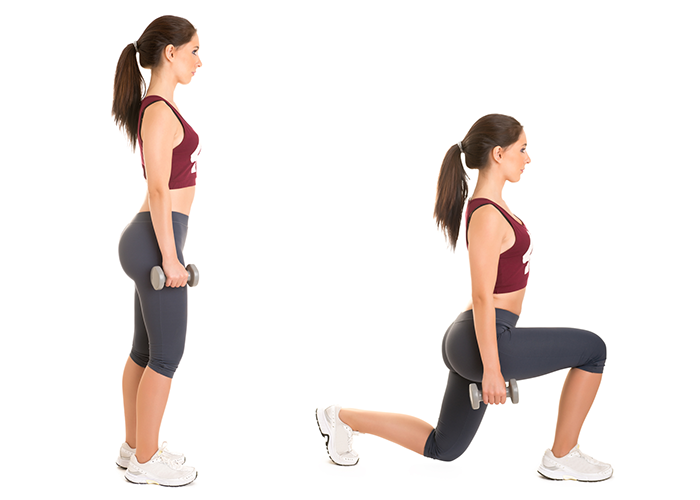
How to do it
- With two dumbbells on either side of your hands, step forward into a lunge.
- Keep in mind that as you sink lower, your front knee shouldn’t go past your toe. If it does, you are putting too much of your weight forward.
- Pause as your back knee nearly touches the floor. Your arms should still be at your side with the weights.
- Rise up and move your back leg forward in a stepping motion as you go into the next lunge (the back leg you started with will now be in front).
- Continue these walking lunges for 10 reps.
2. Burpees | 10 reps
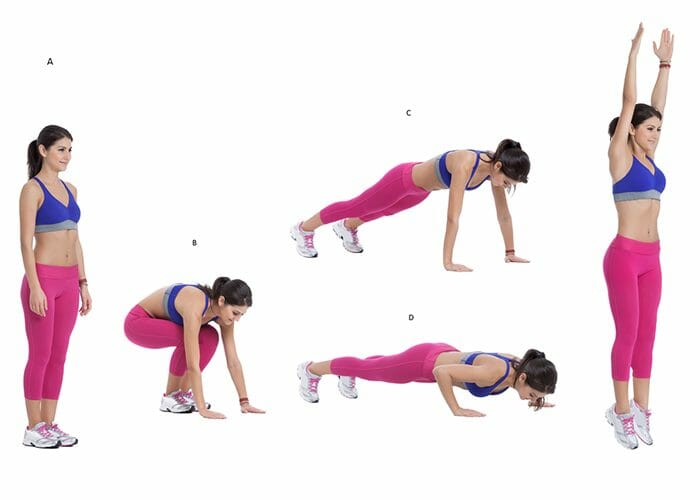
How to do it
- Begin standing and then crouch down on all fours, then get into a push-up position.
- Do one push-up.
- Bring your back legs forward to meet your hands in one jump.
- Stand up and jump up with your arms raised (like you’re trying to touch the sky).
- Get back to the beginning stance. Lower your arms and begin again.
- Repeat for 10 reps.
Beginner Tip: If you want to modify burpees for a beginner level, do the push-up on your knees. Additionally, you can stand up without jumping at the end of the move too. Gradually, you can include the full workout for maximum cardio impact.
3. Kettlebell Goblet Squats | 10 reps
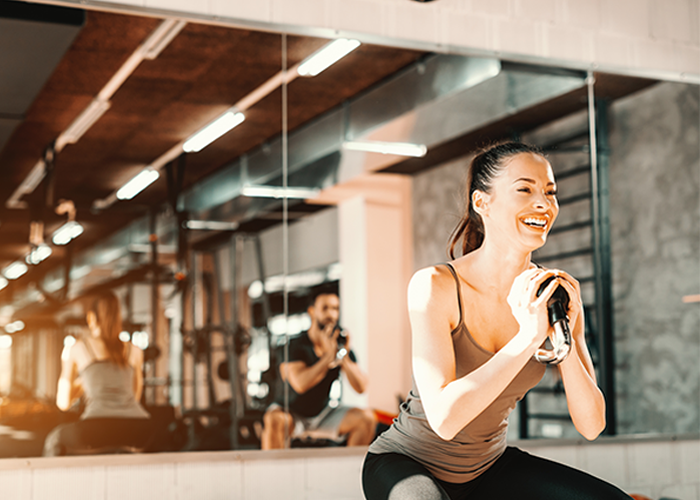
How to do it
- Start by holding the kettlebell at chest level, with your elbows pointed down.
- As you lower into a squat, focus your weight in your hips. It’s crucial to look forward so as not to risk bending your back forward and throwing off your balance.
- Pause at the bottom before rising back up to your starting position.
- Continue for 10 reps.
Pro Tip: To take this move to the next level, lift your arms with the kettlebell after the squat rise. If you want an even bigger challenge, lift the kettlebell overhead and jump up after each squat.
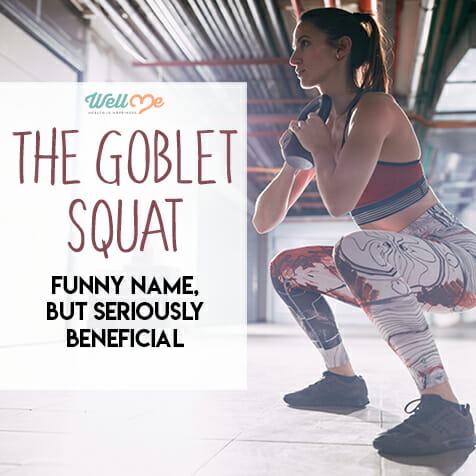
Conclusion
Not only are goblet squats fun and versatile, but they can also be done anywhere too. If you need a quick workout at home, try to squeeze in ten while you wait for your pasta to boil. Before long you’ll feel how beneficial these simple moves can be for your everyday life. Remember: never underestimate the power of a proper squat.
Read Next: Says NO to Body Shaming by Body Positive Workout Plan!

